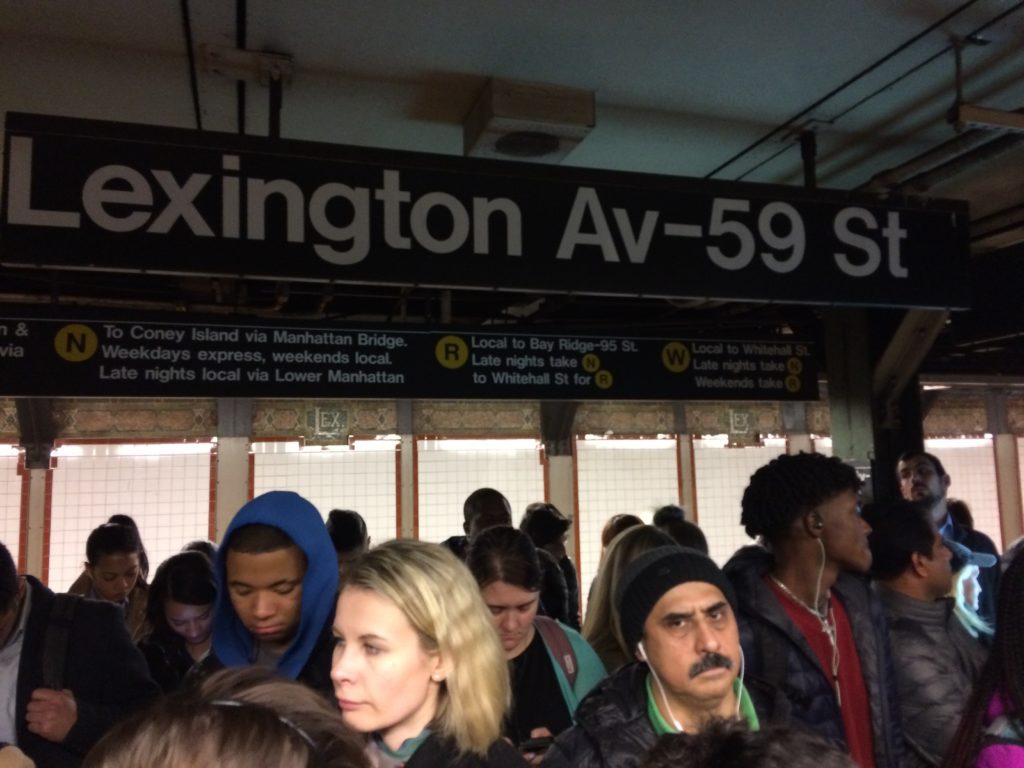The popularity of the city-run subway literally brought down Manhattan’s once-popular elevated train tracks in the 1940s and 50s, with the last – the Third Avenue “El” shutting down service in 1955. It carried more than 25,000,000 in 1954. Until the Second Avenue Subway began service in 2016, the Lexington Avenue subway was the only line serving the increasingly populous Upper East Side and East Midtown.
In 1959, development and population growth along the Lexington Avenue line led the Transit Authority to undertake a $130 million modernization program to enhance stations and lengthen platforms and trains to accommodate greater ridership. This modernization plan included making the Lex/59 St station an express stop on the 4/5 lines.
Lex/59 St originally housed only local train service, with express 4/5 trains going directly from 86 Street to Grand Central/42 Street.
Serving an estimated 10 million riders a year in 1959, the New York City Transit Authority began a three year project to allow the express service deeply below 59th Street. By expanding express service to the station, the Transit Authority expected the following benefits:
- Reduce Grand Central congestion due to local and express transfers at Lex/59 St
- Reduce Grand Central Shuttle congestion by providing N, R, or W service to the West Side
- Provide convenient N, R, and W transfers for Queens riders to Lexington line 4/5 express trains
- Eliminate the need for express riders to transfer to local service
Today, the 4/5/6 Lexington Avenue line is the most heavily traveled corridor in the NYC Transit subway system and as a result, trains are often overcrowded and stations along the route are congested.
Among these stations stands Lex/59 St, a major transfer point for riders traveling between Manhattan and Queens. By 2017, the station’s ridership had climbed to over 17 million, almost double than in 1959. The increase in riders entering the station has been compounded by greater numbers of transfers occurring there. Population growth in Queens to upwards of 2.3 million people, as well as continued job growth in Midtown and Downtown Manhattan, has helped to increase transfers at this station.
The N/R/W platform at Lex/59 St is bi-directional and narrow, which causes portions of it to get dangerously congested. With six lines (4/5/6/N/R/W) stopping at the station, combined with a walking F/Q line transfer from Lex/63 St station, transfers can be problematic due to the limitations of the narrow N/R/W platform, often resulting in stairwell and platform crowding. The perpendicular shape of the station causes all transfers between trains to occur at one end of the platform, resulting in pinch-points and stairwell crowding.
As population and subway ridership continues to grow, it is critical to adequately address crowding issues.
The recent rezoning of East Midtown in 2017 will expand development rights in exchange for widening of staircases between the Lex/59 St mezzanine and the N/R/W platforms, but not until a proximate project is identified and gets underway. While these solutions have the potential to alleviate some of the rider flow issues that plague the station, more needs to be done to address crowding issues.
NYC Transit’s Subway Action Plan (SAP), instituted in 2017, has garnered some positive results in reducing system crowding due to delays along each line, which contribute to congested platforms and subway cars. The Fast Forward plan can go further to address critical issues like the station’s geometry and other factors that cause line delays that converge at Lex/59 St. Fast Forward includes the need to upgrade critical infrastructure; review potential route changes to reduce reliance on critical interlockings; and revitalize the station experience. Once these actions are implemented, riders using and transferring at the station will see more reliable service and less crowding.
